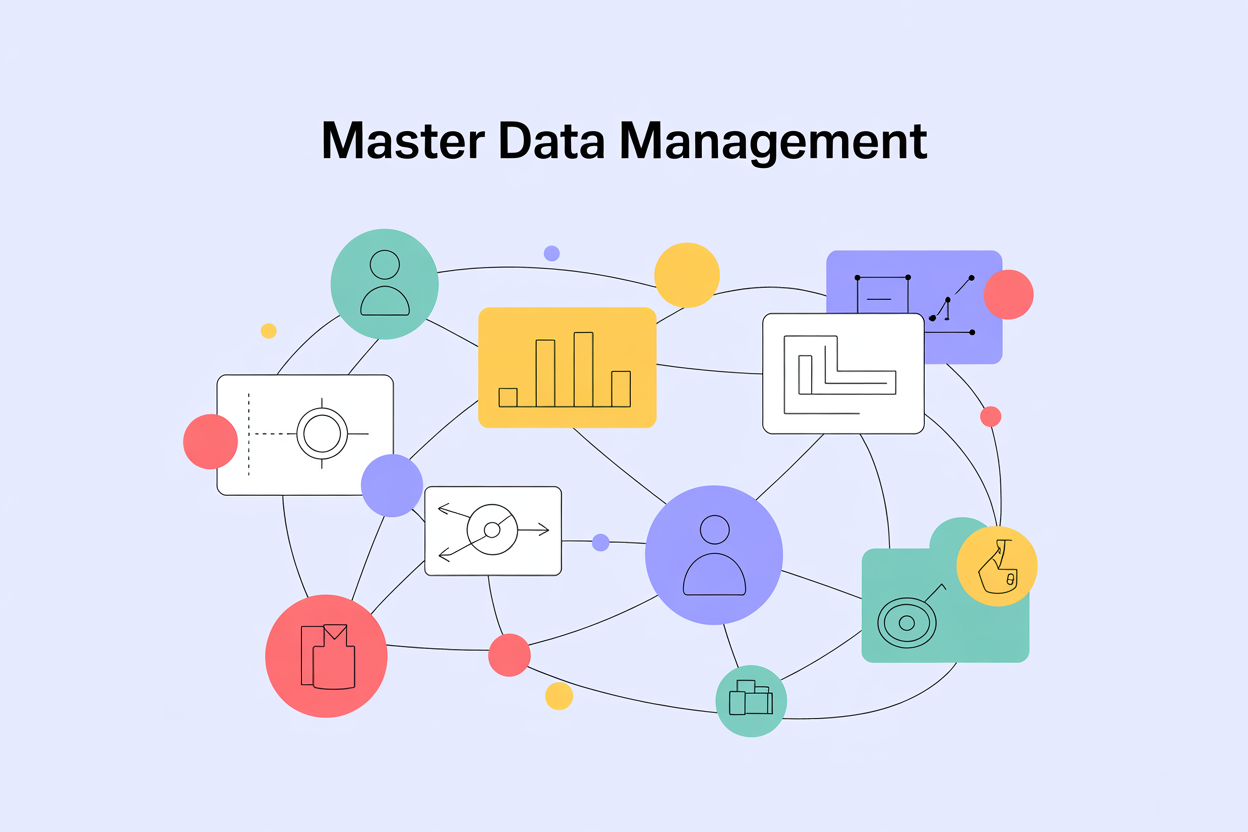Key Takeaways
Master Data is the stable reference information about core business entities like customers, products, suppliers, employees, and locations.
MDM software creates a single, trusted, and consistent view of critical data across systems, acting as the “golden record” for each entity.
Primary benefits of MDM software:
- Ensures data accuracy and consistency.
- Improves operational efficiency by centralizing and standardizing data.
- Supports regulatory compliance with governance, audit trails, and standardized records.
Technical benefits include data integration, reduced duplication, and improved data quality.
Key components of MDM software are: data integration, data quality & cleansing, data governance, data modeling & hierarchies, workflows, data stewardship, and governance framework.
Types of MDM software:
By hosting: On-Premise (e.g., Informatica MDM, AtroCore) and Cloud-Based (e.g., Reltio Cloud, Informatica Cloud MDM).
By licensing: Proprietary (e.g., IBM InfoSphere MDM) and Open Source (e.g., Pimcore, AtroCore).
Check out our detailed guide on the top open-source MDM solutions to better understand your options.
Who Needs MDM the Most?
Organizations with inconsistent data, operational inefficiencies, regulatory requirements, complex multi-system environments, or rapid growth. Certain industries, like retail, healthcare, finance, and manufacturing, rely heavily on MDM.
MDM vs. related concepts:
Metadata Management – focuses on describing and organizing data structures, not consolidating master records.
Data Governance – defines policies and standards; MDM applies them to master data.
PIM (Product Information Management) – specialized for product data; MDM has a broader multi-domain scope.
Understanding Master Data Management (MDM)
Since Master Data Management builds on the concept of master data, we begin by defining the latter.
Simply put, master data is the stable reference information about the who, what, and where of your business. It rarely changes and includes things like customers, products, suppliers, employees, and locations.
This is different from transactional data, which captures business events and activities, such as orders, invoices, or shipments.
Master Data Management (MDM) software is a set of tools that organizations use to create a single, trusted, and consistent view of their most critical data. This includes data about customers, products, suppliers, employees, locations, and other key domains.
Master data works as the “golden record” for an entity (a key business object, like a customer or product). For example, a customer may appear in multiple systems (CRM, billing, support), but MDM ensures there’s one authoritative, accurate profile for that customer. Similarly, a product might be listed differently across e-commerce, ERP, and inventory systems, but MDM keeps it consistent everywhere.
Master Data Management software allows businesses to:
- Provide data security and protect sensitive and organizational data from unauthorized access.
- Enforce standards and policies for data quality and compliance.
- Streamline data integration, updates, and accessibility across systems.
The common features of Master Data Management software include:
- Integrating data from various sources into a centralized MDM system, often through APIs, automated processes, or bulk uploads.
- Defining and applying rules for data consistency, integrity, and security.
- Standardizing, cleansing, and validating data to eliminate duplicates and errors to ensure data consistency.
- Tracking data usage, lineage, and accuracy.
- Implementing controls like role-based access and encryption to protect sensitive information.
- Ensuring that data adheres to organizational and regulatory requirements.
- Generating logs, dashboards, and reports for proper data analytics and governance.
In essence, Master Data Management software provides organizations with a single source of truth for their data. This leads to better decision-making, regulatory compliance, and operational efficiency.
Who Needs Master Data Management Software?
While Master Data Management software manages critical business data, organizations benefit most from it under certain conditions or when specific data challenges arise:
Inconsistent Data
Different departments may hold conflicting information for the same entity. For example, one system might list a customer’s old address while another has their new one. Similar issues can occur with product details, supplier records, or employee information. These inconsistencies cause errors, confusion, and ultimately a poor business and customer experience.
Operational Inefficiency
Without a single source of truth, employees spend unnecessary time reconciling data from multiple systems. For example, a sales team and a marketing team might each maintain their own product lists, which makes it difficult to launch a coordinated campaign.
Poor Decision-Making
When decisions are based on incomplete, duplicate, or inaccurate data, companies risk financial losses, missed opportunities, or even misguided strategies. Reliable master data ensures that decisions are informed and accurate.
Regulatory Compliance and Risk
Organizations subject to regulations such as GDPR or HIPAA need clear, accurate records of sensitive data. Master Data Management software provides the governance and audit trails necessary to demonstrate compliance and reduce risk.
Data Ecosystem Complexity
Businesses that manage large volumes of data across multiple systems, departments, and regions can benefit greatly from Master Data Management software. Data often comes from sources like ERP, CRM, e-commerce platforms, and PIM systems, creating the need for consistent integration. MDM acts as a centralized hub, standardizing data formats and naming conventions across systems. Modern Master Data Management solutions also integrate with external platforms, enabling real-time updates and consistent data sharing.
Data Dependency
Some industries rely heavily on Master Data Management software. Retail and e-commerce use it to centralize product, inventory, and customer data across multiple channels. Healthcare uses MDM to maintain accurate patient records and comply with regulations. Banking and finance rely on it to integrate customer, risk, and compliance data for reporting and fraud prevention. Other industries that commonly use Master Data Management solutions include manufacturing, supply chain, energy, utilities, technology, telecommunications, and logistics.
Growing Pace
Rapidly scaling businesses with increasing data complexity require MDM to prepare for future expansions without data chaos. As businesses add new platforms (e.g., ERP, CRM, or e-commerce systems), inconsistencies in data formats and standards often arise. In this case, investing in a Master Data Management system at the early stage of business growth is the smart strategy.
Simply put, your business does need Master Data Management Software if you:
- Face inconsistent or conflicting data across systems.
- Struggle with operational inefficiencies due to duplicate or scattered data.
- Make decisions based on inaccurate or incomplete information.
- Must comply with strict regulations and require audit-ready records.
- Manage a complex data ecosystem with multiple platforms and departments.
- Operate in industries that rely heavily on MDM, such as retail, e-commerce, healthcare, banking, finance, manufacturing, supply chain, energy, utilities, technology, telecommunications, and logistics.
- Are rapidly growing and adding new systems, creating potential data chaos.
The Impact of Master Data Management Software
Business Benefits
Improved Decision-Making
MDM software ensures that all departments work from the same accurate data, enabling leaders to make informed and timely decisions.
Operational Efficiency
By centralizing and standardizing data, MDM reduces time spent reconciling conflicting information and streamlines daily business processes.
Regulatory Compliance
Master Data Management tools provide proper governance, audit trails, and standardized records, helping organizations meet regulatory requirements and reduce compliance risk.
Technical benefits
Data Integration
Master Data Management software connects multiple systems and applications, and ensures consistent and synchronized data across the organization.
Reduced Duplication
MDM software eliminates redundant or conflicting records, saving storage, reducing errors, and simplifying data management.
Better Data Quality
Master Data Management software enforces data standards and validation rules to keep information accurate, complete, and up to date for all business operations.
Key MDM Components
To understand how MDM works, it helps to look at its core components. These components are the functional building blocks of an MDM system, including both technical capabilities and managing workflows. Each component handles a specific aspect of master data management, from integrating systems to defining data policies and maintaining data quality.
Data Integration
The process of gathering and consolidating data from multiple systems and applications across the organization. This ensures that all relevant master data can be accessed and managed from a centralized location.
Data Quality & Cleansing
Establishing rules and processes to identify and correct errors, remove duplicates, and standardize data. This ensures that the master data remains accurate, complete, and reliable.
Data Governance
The framework of policies, procedures, and responsibilities that defines how master data is created, maintained, and used. This includes assigning roles, defining access rights, and enforcing compliance with internal standards and external regulations.
Data Modeling & Hierarchies
Structuring and organizing master data entities (such as customers, products, suppliers) and defining relationships between them. This helps maintain consistency in how data is represented across systems.
Workflows
Automated or manual processes that manage the ongoing creation, approval, and updating of master data. Workflows ensure that changes follow standardized procedures and are properly documented.
Data Stewardship
The role of individuals or teams responsible for overseeing specific domains of master data. Data stewards monitor quality, ensure adherence to governance policies, and resolve data issues within their domain.
Governance Framework
The overarching system that coordinates policies, roles, responsibilities, and processes across the organization. It defines how decisions about master data are made, how accountability is assigned, and how data standards are enforced consistently.
Types of Master Data Management Software
Master Data Management (MDM) software comes in different types depending on how it is hosted and licensed, allowing organizations to choose the solution that best fits their IT environment, budget, and data needs.
By hosting:
On-Premise MDM is installed on the organization’s own servers, and gives businesses full control over security and customization. It is ideal for those with strict data privacy requirements but requires dedicated IT resources for maintenance. For example, Informatica MDM, and AtroCore.
Cloud-Based MDM is hosted on a cloud platform and accessed over the internet. It offers scalability, faster deployment, and lower upfront costs, with security and compliance shared with the provider. For example, Reltio Cloud, AtroCore, and Informatica Cloud MDM.
By licensing:
Proprietary MDM is commercially developed and licensed, often including enterprise features, support, and updates. For example, IBM InfoSphere MDM.
Open Source MDM provides publicly available code that can be customized and integrated, offering flexibility and lower cost but relying more on in-house expertise or community support. For example, AtroCore, and Pimcore.
Master Data Management Software vs. Related Concepts
Master Data Management (MDM) software is often compared to other data tools. While related, each serves a distinct software purpose:
MDM vs. Metadata Management
MDM software consolidates core business entities like customers, products, and suppliers across systems. In contrast, metadata management software focuses on describing and organizing data structures, such as schemas, data types, and lineage.
MDM vs. Data Governance
Data governance software defines and enforces policies, standards, and rules for organizational data. On the other hand, MDM software applies these rules specifically to master data, ensuring consistency and accuracy across applications.
MDM vs. PIM (Product Information Management)
Product Information Management software specializes in product-related data like descriptions, specifications, and images for marketing or e-commerce. While MDM software has a broader scope, managing multiple domains including products, customers, suppliers, and locations, PIM can be seen as a focused subset within the MDM ecosystem.



